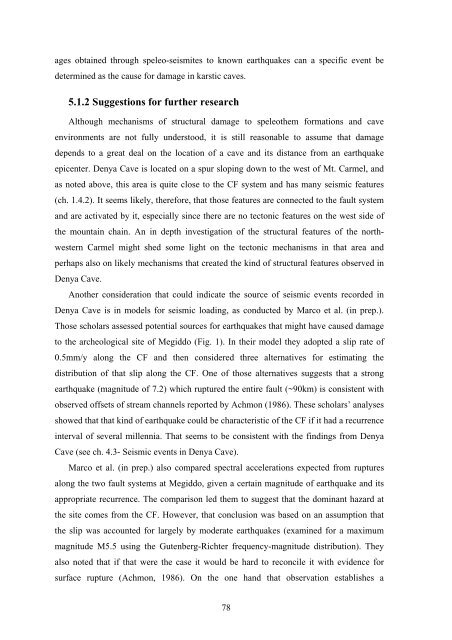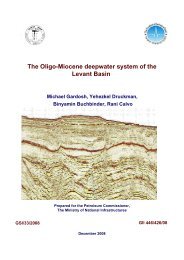tivity on the carmel faul
tivity on the carmel faul
tivity on the carmel faul
You also want an ePaper? Increase the reach of your titles
YUMPU automatically turns print PDFs into web optimized ePapers that Google loves.
ages obtained through speleo-seismites to known earthquakes can a specific event be<br />
determined as <strong>the</strong> cause for damage in karstic caves.<br />
5.1.2 Suggesti<strong>on</strong>s for fur<strong>the</strong>r research<br />
Although mechanisms of structural damage to speleo<strong>the</strong>m formati<strong>on</strong>s and cave<br />
envir<strong>on</strong>ments are not fully understood, it is still reas<strong>on</strong>able to assume that damage<br />
depends to a great deal <strong>on</strong> <strong>the</strong> locati<strong>on</strong> of a cave and its distance from an earthquake<br />
epicenter. Denya Cave is located <strong>on</strong> a spur sloping down to <strong>the</strong> west of Mt. Carmel, and<br />
as noted above, this area is quite close to <strong>the</strong> CF system and has many seismic features<br />
(ch. 1.4.2). It seems likely, <strong>the</strong>refore, that those features are c<strong>on</strong>nected to <strong>the</strong> <strong>faul</strong>t system<br />
and are activated by it, especially since <strong>the</strong>re are no tect<strong>on</strong>ic features <strong>on</strong> <strong>the</strong> west side of<br />
<strong>the</strong> mountain chain. An in depth investigati<strong>on</strong> of <strong>the</strong> structural features of <strong>the</strong> northwestern<br />
Carmel might shed some light <strong>on</strong> <strong>the</strong> tect<strong>on</strong>ic mechanisms in that area and<br />
perhaps also <strong>on</strong> likely mechanisms that created <strong>the</strong> kind of structural features observed in<br />
Denya Cave.<br />
Ano<strong>the</strong>r c<strong>on</strong>siderati<strong>on</strong> that could indicate <strong>the</strong> source of seismic events recorded in<br />
Denya Cave is in models for seismic loading, as c<strong>on</strong>ducted by Marco et al. (in prep.).<br />
Those scholars assessed potential sources for earthquakes that might have caused damage<br />
to <strong>the</strong> archeological site of Megiddo (Fig. 1). In <strong>the</strong>ir model <strong>the</strong>y adopted a slip rate of<br />
0.5mm/y al<strong>on</strong>g <strong>the</strong> CF and <strong>the</strong>n c<strong>on</strong>sidered three alternatives for estimating <strong>the</strong><br />
distributi<strong>on</strong> of that slip al<strong>on</strong>g <strong>the</strong> CF. One of those alternatives suggests that a str<strong>on</strong>g<br />
earthquake (magnitude of 7.2) which ruptured <strong>the</strong> entire <strong>faul</strong>t (~90km) is c<strong>on</strong>sistent with<br />
observed offsets of stream channels reported by Achm<strong>on</strong> (1986). These scholars’ analyses<br />
showed that that kind of earthquake could be characteristic of <strong>the</strong> CF if it had a recurrence<br />
interval of several millennia. That seems to be c<strong>on</strong>sistent with <strong>the</strong> findings from Denya<br />
Cave (see ch. 4.3- Seismic events in Denya Cave).<br />
Marco et al. (in prep.) also compared spectral accelerati<strong>on</strong>s expected from ruptures<br />
al<strong>on</strong>g <strong>the</strong> two <strong>faul</strong>t systems at Megiddo, given a certain magnitude of earthquake and its<br />
appropriate recurrence. The comparis<strong>on</strong> led <strong>the</strong>m to suggest that <strong>the</strong> dominant hazard at<br />
<strong>the</strong> site comes from <strong>the</strong> CF. However, that c<strong>on</strong>clusi<strong>on</strong> was based <strong>on</strong> an assumpti<strong>on</strong> that<br />
<strong>the</strong> slip was accounted for largely by moderate earthquakes (examined for a maximum<br />
magnitude M5.5 using <strong>the</strong> Gutenberg-Richter frequency-magnitude distributi<strong>on</strong>). They<br />
also noted that if that were <strong>the</strong> case it would be hard to rec<strong>on</strong>cile it with evidence for<br />
surface rupture (Achm<strong>on</strong>, 1986). On <strong>the</strong> <strong>on</strong>e hand that observati<strong>on</strong> establishes a<br />
78

















